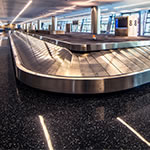The building team for San Diego International Airport’s Terminal 2 expansion and renovation didn’t set out to create the world’s first LEED Platinum-certified commercial airport terminal. The initial goal was LEED Silver, but with the cost of significant sustainable elements within budget, architects and other specialists at HNTB, AECOM, and general contracting joint venture Turner/PCL/Flatiron realized that they could aim higher.
“It was obvious at an early date that we could reach Gold,” says Bob Bolton, the airport’s director of design and construction. “Near the end of the design phase, it started to look like we could get close to Platinum. We didn’t want to go public with that, though, because you never know if you can achieve it until you get official notification from the USGBC.” Guided by rigorous cost-benefit analyses, this Platinum project demonstrates that LEED’s top designation is within reach for airport terminal projects anywhere.

The new terminal, which is LEED Platinum certified, is the largest building project ever undertaken at the San Diego airport. The 470,000-square-foot project added 10 new gates. Photo: Tim Griffith

Site features include drought-tolerant landscaping and a reflective roof, which save water and reduce solar heat gain, respectively. Photo: Frank Rogozienski
In large airport terminals, electric motors for escalators, baggage handling equipment, and pumps and air-handlers for HVAC systems are among the biggest energy hogs. Terminal 2 employs highly efficient variable-speed models for all of these systems. “We received special state approval to install new escalators that slow down when not in use,” Bolton says of the Otis escalators, which use sensors to determine when a person is approaching. (Importantly, the escalator increases speed before, not after, the person sets foot on the first step—a significant safety feature.)
Two other green systems are unique to airport applications: a 400-hertz aircraft power supply and pre-conditioned air supplies. Both feed airplanes at the gates from the building, eliminating the need for planes to run engines between arrival and departure. This both saves jet fuel and improves air quality.

Terminal 2’s atrium is almost entirely daylit, surrounded by windows and a multistory curtainwall featuring high-performance glazing. Photo: Marble Street Studio

Escalators slow down when not in use and use motion sensors to determine when visitors approach. Photo: Marble Street Studio
The building was designed with rooftop solar panels in mind, but how they would be paid for wasn’t settled until later in the project’s development. The most cost-effective option turned out to be a 20-year power-purchase agreement with Borrego Solar Systems. The airport authority avoids spending capital to buy the panels, and its electric rates are locked in for the full 20-year term.
The solar array will provide one megawatt of electricity to the building, accounting for 12.5 percent of the terminal’s electrical needs for an estimated $4-8 million of savings over the next 20 years. Thanks to the energy-efficiency and solar power elements, the project received the maximum 17 points in LEED’s Energy and Atmosphere category.

Only the most efficient escalators and baggage handlers were installed. Photo: Marble Street Studio

Jim Campbell’s art installation, The Journeys, uses 37,000 LED lights. Photo: Frank Rogozienski
Some leading-edge green options did not make the cut. “We did an analysis very early in the program on geothermal and thermal energy storage for hot water, but the payback was not optimal,” says Tom Rossbach, a principal at HNTB. A rainwater capture system couldn’t be justified either, given San Diego’s low annual rainfall.
Some systems, by contrast, were no-brainers: “Lighting controls can pay off in as [little] as nine months,” Rossbach says, and “LED lighting can pay for itself in one year.”
Other notable green features include white reflective roofing, drought-tolerant landscaping, low-flow plumbing fixtures, and shaded fenestration for the large atrium, with darker glass near the top and lighter glass at the bottom to reduce heat gain.

